Abstract
A prospective study of the clinical and epidemiological features of the haemolytic uraemic syndromes was conducted over a three year period in the British Isles. Two hundred and ninety eight children were reported. In two thirds of cases stool samples were analysed for the presence of Verocytotoxin producing Escherichia coli (VTEC) and neutralisable Verocytotoxin. A total of 273 (95%) patients had a prodrome of diarrhoea. In these a seasonal variation in the incidence of haemolytic uraemic syndrome was demonstrated, the 1-2 year age range was most often affected, and the peripheral blood neutrophil count correlated positively with an adverse outcome. Patients presenting without diarrhoea showed none of these associations and had a significantly greater morbidity and mortality. Evidence for VTEC infection was found in 58 (33%) of 178 diarrhoea associated cases whose stools were analysed, although VTEC were identified in five of eight (62%) patients whose stools were collected within three days of the onset of diarrhoea. Most isolates produced VT2 either alone, or together with VT1. There was no evidence of VTEC infection in patients without prodromal diarrhoea.
Full text
PDF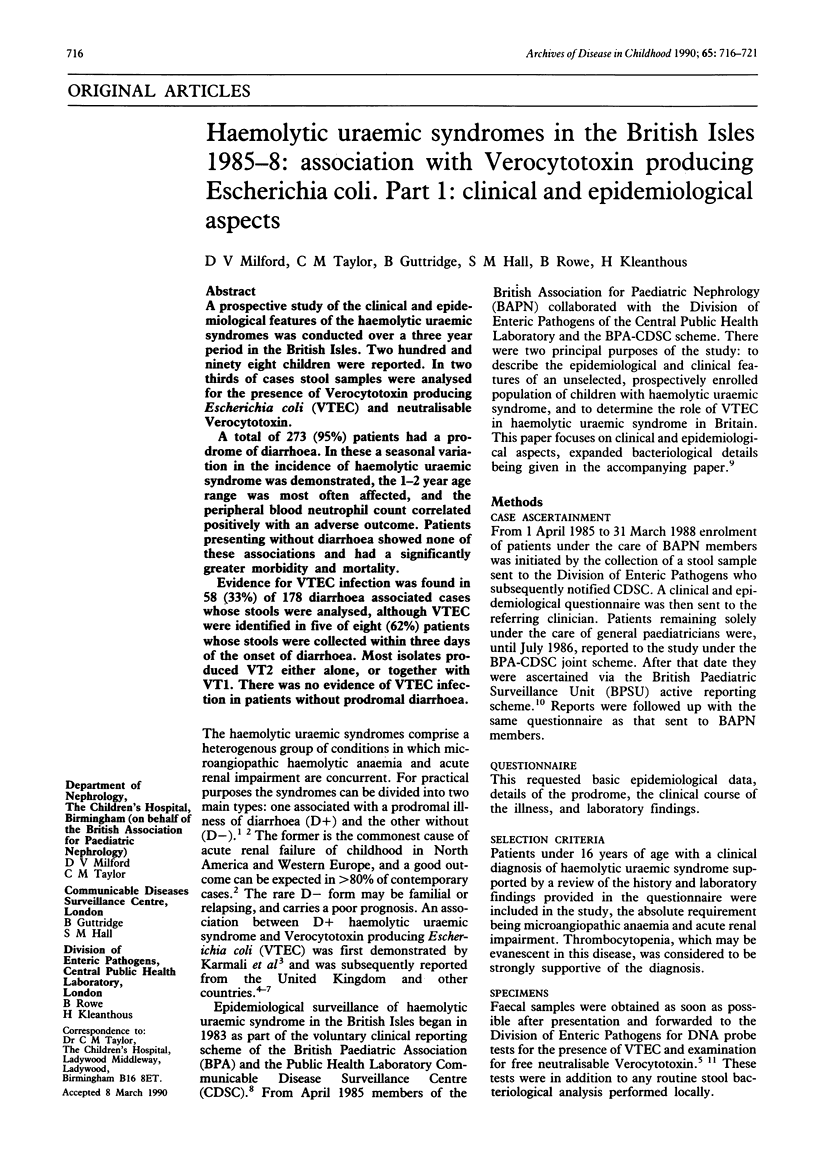
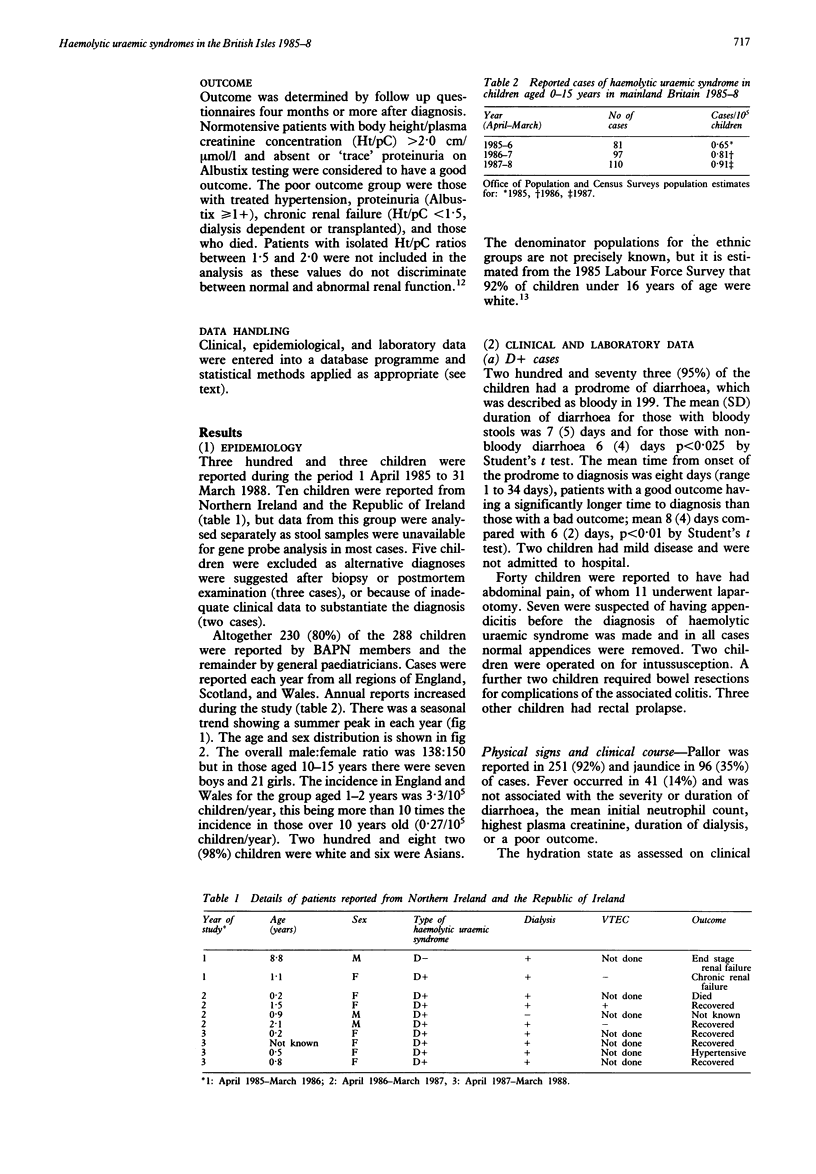
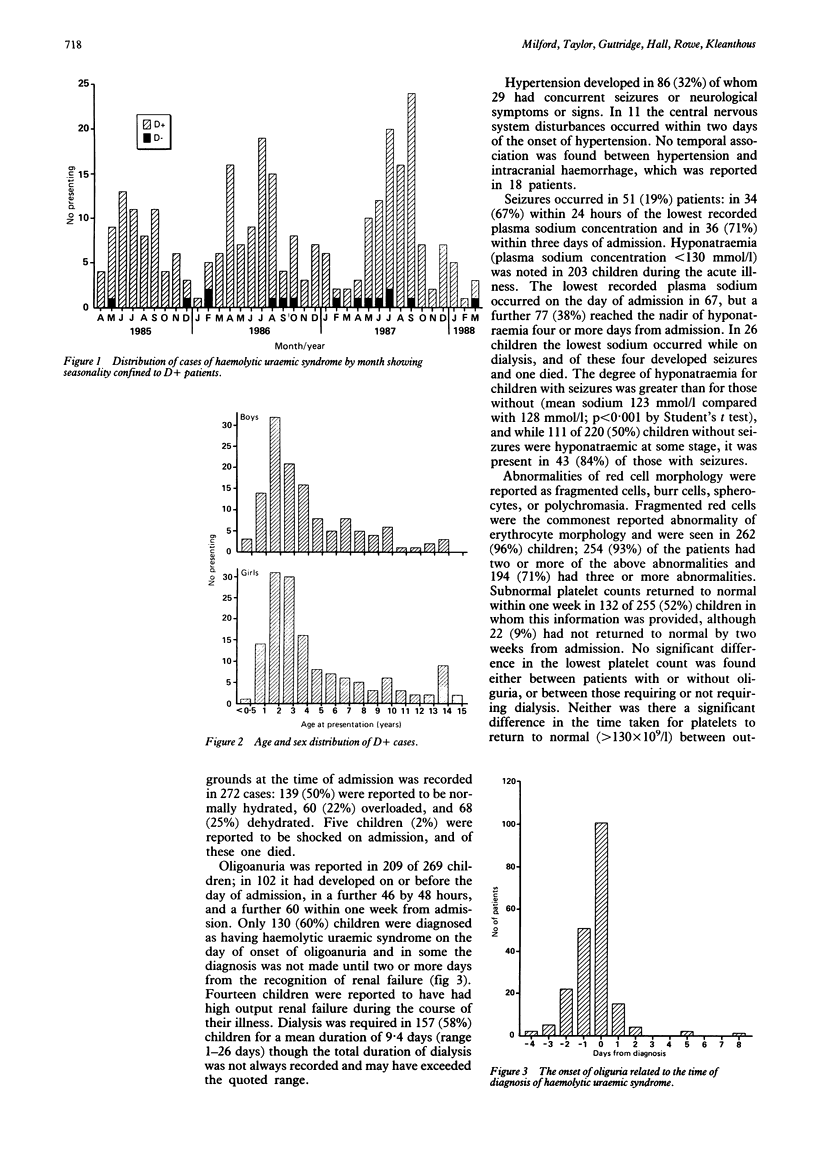

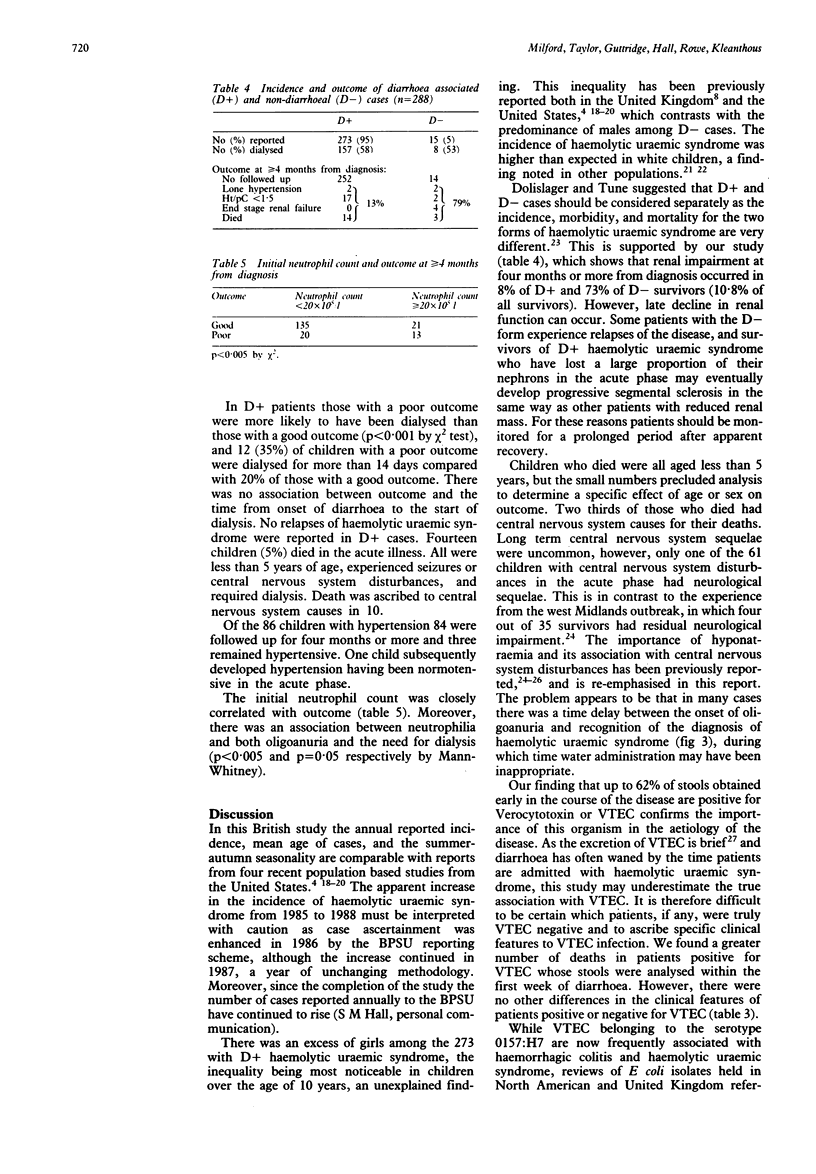
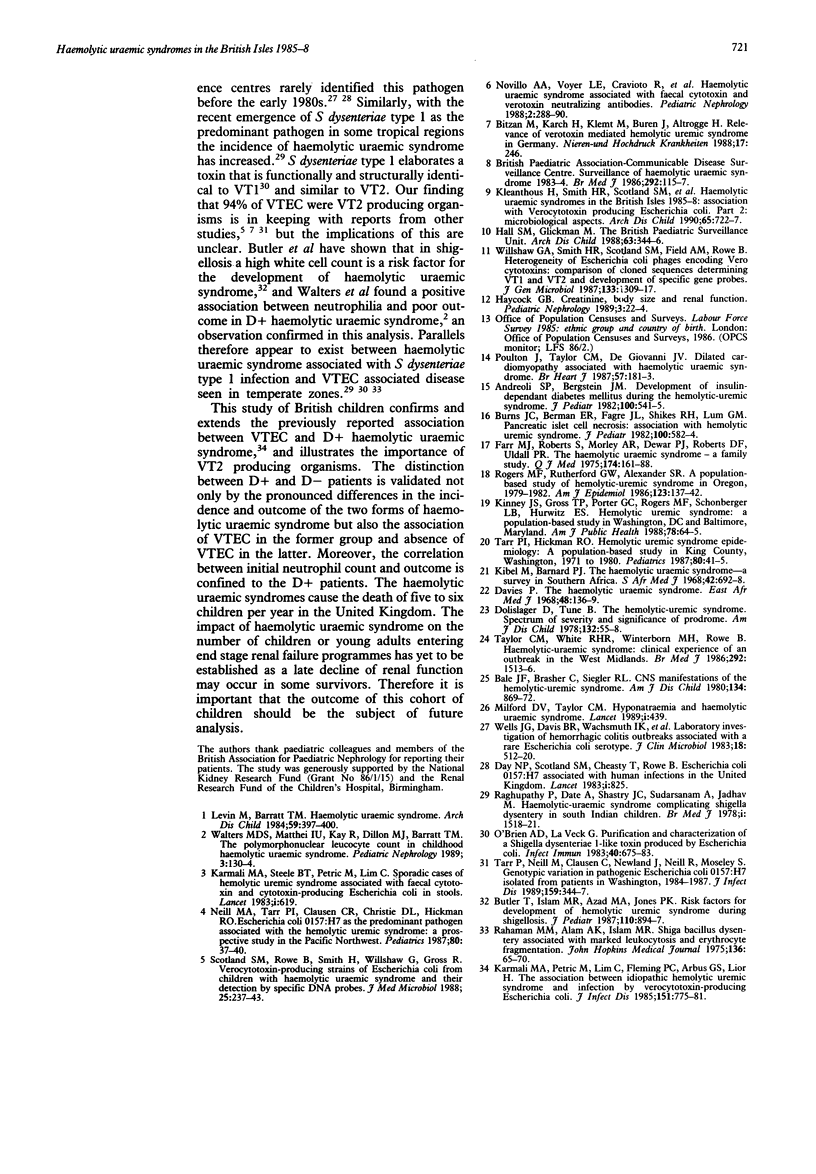
Selected References
These references are in PubMed. This may not be the complete list of references from this article.
- Andreoli S. P., Bergstein J. M. Development of insulin-dependent diabetes mellitus during the hemolytic-uremic syndrome. J Pediatr. 1982 Apr;100(4):541–545. doi: 10.1016/s0022-3476(82)80749-x. [DOI] [PubMed] [Google Scholar]
- Bale J. F., Jr, Brasher C., Siegler R. L. CNS manifestations of the hemolytic-uremic syndrome. Relationship to metabolic alterations and prognosis. Am J Dis Child. 1980 Sep;134(9):869–872. doi: 10.1001/archpedi.1980.02130210053014. [DOI] [PubMed] [Google Scholar]
- Burns J. C., Berman E. R., Fagre J. L., Shikes R. H., Lum G. M. Pancreatic islet cell necrosis: association with hemolytic-uremic syndrome. J Pediatr. 1982 Apr;100(4):582–584. doi: 10.1016/s0022-3476(82)80758-0. [DOI] [PubMed] [Google Scholar]
- Butler T., Islam M. R., Azad M. A., Jones P. K. Risk factors for development of hemolytic uremic syndrome during shigellosis. J Pediatr. 1987 Jun;110(6):894–897. doi: 10.1016/s0022-3476(87)80405-5. [DOI] [PubMed] [Google Scholar]
- Day N. P., Scotland S. M., Cheasty T., Rowe B. Escherichia coli O157:H7 associated with human infections in the United Kingdom. Lancet. 1983 Apr 9;1(8328):825–825. doi: 10.1016/s0140-6736(83)91887-1. [DOI] [PubMed] [Google Scholar]
- Dolislager D., Tune B. The hemolytic-uremic syndrome: spectrum of severity and significance of prodrome. Am J Dis Child. 1978 Jan;132(1):55–58. doi: 10.1001/archpedi.1978.02120260057014. [DOI] [PubMed] [Google Scholar]
- Farr M. J., Roberts S., Morley A. R., Dewar D. F., Uldall P. R. The haemolytic uraemic syndrome--a family study. Q J Med. 1975 Apr;44(174):161–188. [PubMed] [Google Scholar]
- Hall S. M., Glickman M. The British Paediatric Surveillance Unit. Arch Dis Child. 1988 Mar;63(3):344–346. doi: 10.1136/adc.63.3.344. [DOI] [PMC free article] [PubMed] [Google Scholar]
- Haycock G. B. Creatinine, body size and renal function. Pediatr Nephrol. 1989 Jan;3(1):22–24. doi: 10.1007/BF00859619. [DOI] [PubMed] [Google Scholar]
- Karmali M. A., Petric M., Lim C., Fleming P. C., Arbus G. S., Lior H. The association between idiopathic hemolytic uremic syndrome and infection by verotoxin-producing Escherichia coli. J Infect Dis. 1985 May;151(5):775–782. doi: 10.1093/infdis/151.5.775. [DOI] [PubMed] [Google Scholar]
- Kinney J. S., Gross T. P., Porter C. C., Rogers M. F., Schonberger L. B., Hurwitz E. S. Hemolytic-uremic syndrome: a population-based study in Washington, DC and Baltimore, Maryland. Am J Public Health. 1988 Jan;78(1):64–65. doi: 10.2105/ajph.78.1.64. [DOI] [PMC free article] [PubMed] [Google Scholar]
- Kleanthous H., Smith H. R., Scotland S. M., Gross R. J., Rowe B., Taylor C. M., Milford D. V. Haemolytic uraemic syndromes in the British Isles, 1985-8: association with verocytotoxin producing Escherichia coli. Part 2: Microbiological aspects. Arch Dis Child. 1990 Jul;65(7):722–727. doi: 10.1136/adc.65.7.722. [DOI] [PMC free article] [PubMed] [Google Scholar]
- Levin M., Barratt J. M. Haemolytic uraemic syndrome. Arch Dis Child. 1984 May;59(5):397–400. doi: 10.1136/adc.59.5.397. [DOI] [PMC free article] [PubMed] [Google Scholar]
- Milford D., Taylor C. M. Hyponatraemia and haemolytic uraemic syndrome. Lancet. 1989 Feb 25;1(8635):439–439. doi: 10.1016/s0140-6736(89)90033-0. [DOI] [PubMed] [Google Scholar]
- Neill M. A., Tarr P. I., Clausen C. R., Christie D. L., Hickman R. O. Escherichia coli O157:H7 as the predominant pathogen associated with the hemolytic uremic syndrome: a prospective study in the Pacific Northwest. Pediatrics. 1987 Jul;80(1):37–40. [PubMed] [Google Scholar]
- Novillo A. A., Voyer L. E., Cravioto R., Freire M. C., Castaño G., Wainstein R., Binztein N. Haemolytic uraemic syndrome associated with faecal cytotoxin and verotoxin neutralizing antibodies. Pediatr Nephrol. 1988 Jul;2(3):288–290. doi: 10.1007/BF00858679. [DOI] [PubMed] [Google Scholar]
- O'Brien A. D., LaVeck G. D. Purification and characterization of a Shigella dysenteriae 1-like toxin produced by Escherichia coli. Infect Immun. 1983 May;40(2):675–683. doi: 10.1128/iai.40.2.675-683.1983. [DOI] [PMC free article] [PubMed] [Google Scholar]
- Poulton J., Taylor C. M., De Giovanni J. V. Dilated cardiomyopathy associated with haemolytic uraemic syndrome. Br Heart J. 1987 Feb;57(2):181–183. doi: 10.1136/hrt.57.2.181. [DOI] [PMC free article] [PubMed] [Google Scholar]
- Raghupathy P., Date A., Shastry J. C., Sudarsanam A., Jadhav M. Haemolytic-uraemic syndrome complicating shigella dystentery in south Indian children. Br Med J. 1978 Jun 10;1(6126):1518–1521. doi: 10.1136/bmj.1.6126.1518. [DOI] [PMC free article] [PubMed] [Google Scholar]
- Rahaman M. M., JamiulAlam A. K., Islam M. R., Greenough W. B., 3rd Shiga bacillus dysentery associated with marked leukocytosis and erythrocyte fragmentation. Johns Hopkins Med J. 1975 Feb;136(2):65–70. [PubMed] [Google Scholar]
- Rogers M. F., Rutherford G. W., Alexander S. R., DiLiberti J. H., Foster L., Schonberger L. B., Hurwitz E. S. A population-based study of hemolytic-uremic syndrome in Oregon, 1979-1982. Am J Epidemiol. 1986 Jan;123(1):137–142. doi: 10.1093/oxfordjournals.aje.a114207. [DOI] [PubMed] [Google Scholar]
- Tarr P. I., Neill M. A., Clausen C. R., Newland J. W., Neill R. J., Moseley S. L. Genotypic variation in pathogenic Escherichia coli O157:H7 isolated from patients in Washington, 1984-1987. J Infect Dis. 1989 Feb;159(2):344–347. doi: 10.1093/infdis/159.2.344. [DOI] [PubMed] [Google Scholar]
- Taylor C. M., White R. H., Winterborn M. H., Rowe B. Haemolytic-uraemic syndrome: clinical experience of an outbreak in the West Midlands. Br Med J (Clin Res Ed) 1986 Jun 7;292(6534):1513–1516. doi: 10.1136/bmj.292.6534.1513. [DOI] [PMC free article] [PubMed] [Google Scholar]
- Walters M. D., Matthei I. U., Kay R., Dillon M. J., Barratt T. M. The polymorphonuclear leucocyte count in childhood haemolytic uraemic syndrome. Pediatr Nephrol. 1989 Apr;3(2):130–134. doi: 10.1007/BF00852893. [DOI] [PubMed] [Google Scholar]
- Wells J. G., Davis B. R., Wachsmuth I. K., Riley L. W., Remis R. S., Sokolow R., Morris G. K. Laboratory investigation of hemorrhagic colitis outbreaks associated with a rare Escherichia coli serotype. J Clin Microbiol. 1983 Sep;18(3):512–520. doi: 10.1128/jcm.18.3.512-520.1983. [DOI] [PMC free article] [PubMed] [Google Scholar]


